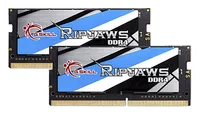Best Laptop Memory Upgrades: 8 DDR4 SODIMM Kits Tested & Compared
What to Consider Before Updating Your Laptop Memory
Why you can trust Tom's Hardware
On the preceding pages, we walked you through our benchmark tests for eight SODIMM kits and an overview of each product, starting with the single-DIMM results and followed by the dual-DIMM ones. You can dig into the details there on a product-by-product basis, but here's our bottom line: Buying SODIMMs is way more about what you can install than what you might want to install. As a result, you generally shouldn't obsess over maximizing SODIMM speed, except under certain very narrow circumstances.
The money you might spend maximizing RAM speed isn't likely to make a huge real-world difference. That's generally true in the desktop realm, as well, except when playing PC games on integrated graphics, as we saw in our AMD Raven Ridge memory scaling story, AMD Ryzen 5 2400G Tests: How Much Does Memory Impact Gaming? Given that most gaming-focused laptop users will almost certainly have a dedicated graphics chip, maximum memory speed isn’t going to make a major difference.
In the end, once you’ve whittled down the memory modules that will work with your system, if you’re looking for the best balance of performance and price, our advice is (obviously) to make sure you’re running at least two SODIMM sticks (if at all possible) for the extra bandwidth that comes from doubling your memory channels. Then, to nudge the performance needle a little further forward, consider dense dual-rank kits with lots of integrated circuits, to increase the bandwidth even more.
Beyond that, if you want to splurge on high-speed, overclockable memory and your system supports it, you certainly have options. But given the high price of memory these days, and the diminishing returns of expensive RAM with all the possible megahertz, we’d suggest saving that money for other upgrades (say a faster/roomier boot drive) or saving your cash for a future laptop or SFF desktop. Perhaps, by the time you have enough for a new machine, memory prices will have fallen, and new and better graphics chips will be available. We can only hope, but hoping for a better hardware tomorrow might just be a better bet than overspending on expensive RAM today that doesn’t give you much (if any) noticeable benefit.
OK, But I Still Want to Upgrade. Which of These Kits Are Best?
Of the eight kits tested here, to a certain extent the "best" kits are the ones you can install, or whose timings your laptop supports.
Also, let's take the most common upgrade situations.
Some folks are limited by the vagaries of an existing installed module. They're just trying to match the one they have installed as best they can to boost RAM capacity. Their "value" calculation is limited by what they already have installed. They may have to match their existing memory since the installed module is not easily accessible (i.e., they can't swap it out), or their budget precludes swapping out the existing memory; they simply need to augment, not replace.
Others have just one SODIMM slot to play with, and are aiming to swap out an existing lesser-capacity module in that single slot with a bigger-capacity one. Of course, they are working within the spec limitations of the laptop, and that limits their choice pool. Their sole objective is to buy a bigger module than what they had installed before (and maybe one that is faster, too, if their system supports it).
Other upgraders may have two slots to play with, and mean to fill both slots with new modules. That's a similar objective to the previous upgrader's, but again limited by what the system supports.
So, What To Do?
To make sense of these disparate upgrade and/or install situations, we have to split up our recommendations.
If you are in a situation where you have the flexibility to install high-speed RAM, the subset to consider is way different. Assuming you can use it, we like the 2666 Ripjaws kit for its balance, as well as the HyperX...
That said, most of the modules tested here offer solid value to laptop users who simply need more memory capacity. And the single modules could be particularly useful in those upgrade situations where you have only a single slot to work with. For these users, Super Talent DDR4-2400’s lower price--assuming it stays low, relative to the rest--will be a big draw.
That said, none of these modules raised a red flag on performance. And indeed, the sheer benefit of more RAM capacity than you had before should outweigh the mild performance differences among specific apps, assuming you choose a suitable kit within the limitations of your laptop's memory support.
MORE: Best Memory
MORE: DDR DRAM FAQs And Troubleshooting Guide
MORE: All Memory Content
Current page: What to Consider Before Updating Your Laptop Memory
Prev Page Dual-Channel SODIMM Laptop Memory Kits - Tests and BenchmarksGet Tom's Hardware's best news and in-depth reviews, straight to your inbox.
Tom's Hardware is the leading destination for hardcore computer enthusiasts. We cover everything from processors to 3D printers, single-board computers, SSDs and high-end gaming rigs, empowering readers to make the most of the tech they love, keep up on the latest developments and buy the right gear. Our staff has more than 100 years of combined experience covering news, solving tech problems and reviewing components and systems.
-
honkuimushi I would have liked to see entries from Corsair and Micron but this is a good overview. Would it be too much to ask for a revisit with the Zotac MA551 Raven Ridge based SFFC when it's released? That might provide a better reason for higher clocked memory, and dual rank might actually be a hindrance.Reply -
phil brinkle What DRAM chips do all these memory modules use? I haven't found any information on this in the review.Reply



